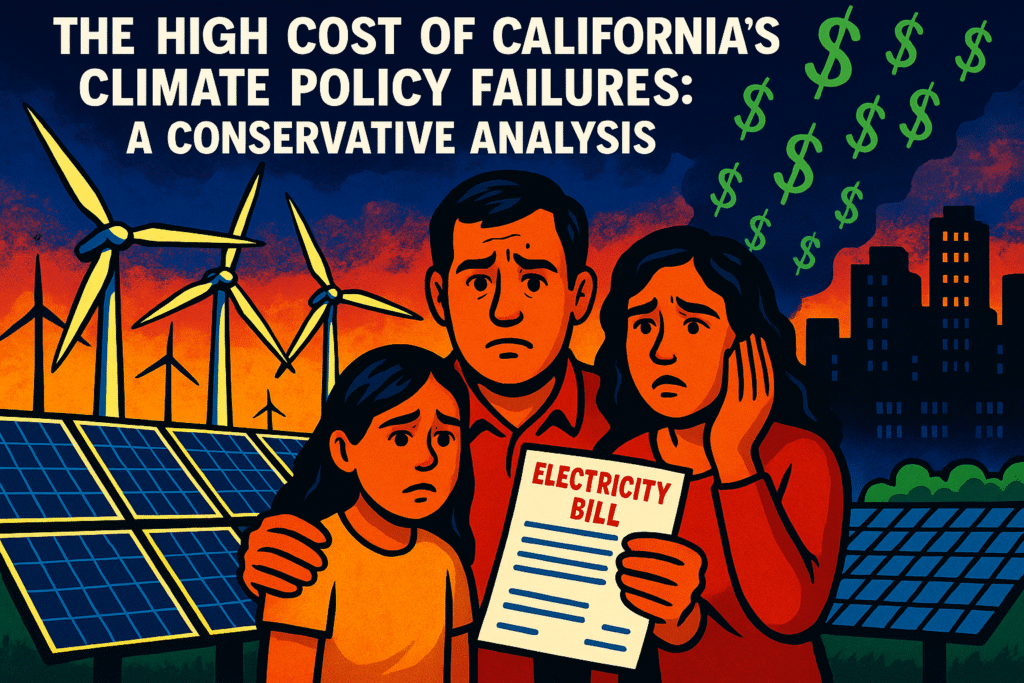The High Cost of California’s Climate Policy Failures: A Conservative Analysis


Once heralded as a global leader in environmental stewardship, California is now grappling with the unintended consequences of its aggressive climate and environmental policies. While the state’s progressive leadership touts ambitious goals for carbon neutrality and renewable energy, the reality is far less rosy for ordinary Californians. From soaring energy bills to failing green projects and widespread regulatory overreach, the Golden State’s climate agenda has become a cautionary tale of ideology overriding common sense. This article explores, from a conservative perspective, why California’s climate policy failures are hurting—not helping—its people, its economy, and its environment.
The Push for Aggressive Climate Action
California’s government has set some of the nation’s most stringent climate goals, aiming for 100% clean electricity by 2045 and strict emissions reductions across multiple sectors. These policies are enforced through a slew of regulations, mandates, and incentive programs for everything from electric vehicles to building codes.
Supporters argue that California is setting an example for the nation and the world. But when you scratch beneath the surface, the costs and failures become evident—especially for families, small businesses, and rural communities.
Skyrocketing Energy Costs
One of the most immediate impacts of California’s climate policies is the dramatic increase in energy costs. The state’s renewable energy mandates, combined with the decommissioning of reliable natural gas and nuclear power plants, have strained the electric grid and driven prices to record highs. Californians now pay among the highest electricity rates in the nation, with prices continuing to climb.
For low- and middle-income families, these rising costs are a growing burden. The promise of “green jobs” and clean energy savings has not materialized for the average household struggling to pay their utility bills. Meanwhile, rolling blackouts and power shortages have exposed the fragility of an over-ambitious energy transition that outpaces current technology and infrastructure.
Green Projects That Fail to Deliver
California has poured billions of taxpayer dollars into high-profile green projects, often with disappointing results. The state’s high-speed rail project, initially justified as a way to reduce car emissions, is years behind schedule and billions over budget—with little to show for the investment. Similarly, massive subsidies for electric vehicles and solar panels have primarily benefited wealthy residents, while imposing hidden costs on everyone else.
In many cases, funds earmarked for environmental initiatives are siphoned off by bureaucratic inefficiency and mismanagement. The result? Little measurable impact on global climate, but significant financial pain for taxpayers.
Regulatory Overreach and Job Losses
California’s climate regulations extend far beyond energy; they touch nearly every aspect of life and business. Farmers face strict limits on water usage and fertilizer, trucking companies must replace fleets with expensive electric vehicles, and new housing developments are burdened with costly “green” requirements.
These rules don’t just raise prices—they cost jobs. Small businesses and manufacturers, squeezed by compliance costs and regulatory uncertainty, are increasingly relocating to states with more balanced policies. California’s share of America’s manufacturing workforce is shrinking, and rural economies are suffering under the weight of one-size-fits-all mandates.
The Unintended Environmental Consequences
Ironically, some of California’s most well-intentioned environmental policies have produced negative side effects. For example, aggressive wildfire prevention strategies have been hampered by environmental regulations that limit forest management and brush clearing. As a result, wildfires have grown more intense and destructive, undoing decades of progress in conservation.
In the rush to promote renewables, the state has neglected reliable power sources and hindered the construction of new reservoirs and water infrastructure. This has left California vulnerable to droughts and contributed to water shortages that harm both people and wildlife.
Who Really Benefits?
A close look at California’s climate agenda reveals that the biggest winners are not ordinary citizens, but well-connected corporations and special interests. Renewable energy companies, labor unions, and environmental lobbyists have all profited handsomely from taxpayer-funded programs and government contracts. Meanwhile, everyday Californians bear the brunt of higher costs and fewer opportunities.
The Conservative Alternative: Pragmatic, Balanced Solutions
Conservatives are not opposed to environmental protection or responsible stewardship. The difference lies in the approach. Instead of heavy-handed mandates and top-down controls, conservatives advocate for policies that balance economic growth with environmental care:
1. Embrace All-of-the-Above Energy
Rather than betting everything on intermittent renewables, California should support a diverse energy mix—including clean natural gas, advanced nuclear, and new technologies. This ensures reliability, affordability, and resilience against blackouts.
2. Streamline Regulations
Excessive red tape stifles innovation and drives up costs. California should review and reform its climate regulations, focusing on outcomes rather than rigid mandates. Local communities and businesses should have flexibility to find solutions that work for them.
3. Invest in Infrastructure
Instead of wasteful projects like high-speed rail, prioritize investments in wildfire prevention, water storage, and modernizing the power grid. These practical steps yield tangible benefits for people and the environment.
4. Support Market-Based Incentives
Let entrepreneurs and innovators drive progress, not government bureaucrats. Market-based incentives, such as voluntary conservation programs and emissions trading, have a proven track record of delivering results without crushing economic opportunity.
5. Respect Property Rights
Landowners, farmers, and small businesses are stewards of the land. Policies should empower them to protect natural resources without sacrificing their livelihoods.
Conclusion
California’s climate and environmental policies, for all their lofty rhetoric, have failed to deliver for the people who live and work in the state. The costs are real, the benefits are elusive, and the unintended consequences are mounting. It’s time for a more balanced, pragmatic approach—one that respects both the environment and the economic realities of ordinary Californians. Only then will California truly lead the nation, not just in ambition, but in results.













